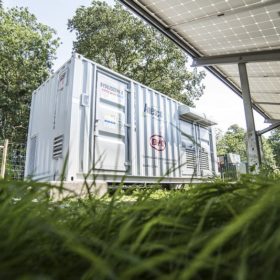Unlimited energy storage in Europe
Most studies of European 100% renewable energy overlook pumped-hydro energy storage (PHES), for the following, incorrect, reasons: there are few PHES sites; more dams on rivers are required; large areas of land are flooded; large amounts of water are required; there is a heavy environmental cost; and the capital cost of PHES is high. All these perceptions are wrong.
Combining liquid-based direct air capture with compressed air energy storage
Scientists in China have simulated a system that combines liquid-based direct air capture with diabatic compressed air energy storage, for the benefit of both processes. Exploring its economic feasibility, they found the system could achieve a levelized cost of energy of $0.53/kWh and a levelized cost of CO2 captured from air of $259/tCO2.
China unveils nuclear-powered battery with millennium-long lifespan
Beita Pharmatech and Northwest Normal University have develop a carbon-14 nuclear battery encased in silicon carbide, offering unprecedented longevity and application potential.
UK regulator reveals criteria for long-duration storage
Long duration energy storage (LDES) support scheme will have eight-hour minimum. First application round opens to well-established technologies, such as lithium-ion battery technology, with at least 100 MW capacity in April 2025. Flow batteries, compressed air, and liquid air likely to progress in second round, says regulator.
The Hydrogen Stream: Hyundai Motor plans fuel cell plant in South Korea
Hyundai Motor says it plans to build its first hydrogen fuel cell systems plant in South Korea by 2028, pending union consultations, expanding beyond its existing facility in China.
Water generates electrical charge 10 times stronger than expected
Electricity generated by water moving across a surface can be 10 times more powerful than previously thought, according to Australian researchers who say their finding could boost energy storage and charging rates and improve safety in fuel-holding systems.
Chinese PV Industry Brief: Huaneng, TBEA announce GW-scale renewables clusters
TBEA says it will invest CNY 10.16 billion ($1.4 billion) in 3 GW of solar and wind projects with storage, backed by equity and syndicated loans, as part of plans to complete the solar plant by 2025 and wind project by 2026.
Gentari gives go-ahead for DC-coupled solar, storage in Australia
Construction of the Maryvale Solar and Energy Storage project is set to begin in the coming weeks with renewables developer Gentari pressing go on the DC-coupled hybrid project being built in central western New South Wales.
EU approves aid for 1.5 GWh storage rollout in Czechia
The aid will take form of direct grants which will cover up to 50% of the investment cost of supported projects.
Atess Power launches 1,500 kW battery for C&I solar
Atess Power has released a 1,500 kW battery for commercial and industrial (C&I) solar, with up to eight units operating in parallel for 12 MW of capacity. The Chinese inverter manufacturer also offers 1,000 kW and 1,200 kW models.










